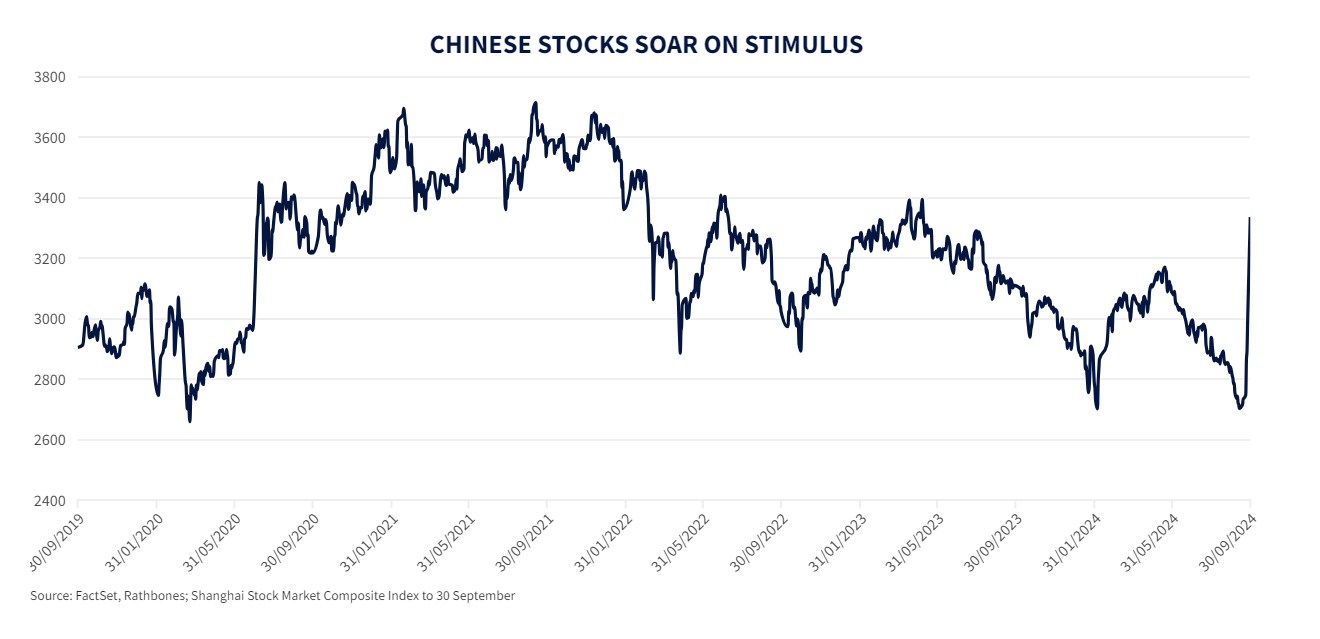
The return of the dragon
THE YEAR OF THE DRAGON HASN’T BEEN AN AUSPICIOUS ONE FOR CHINA SO FAR. ITS LEADERS ARE TRYING TO TURN THAT AROUND WITH A WALL OF MONEY TO KICKSTART ITS SPUTTERING ECONOMY.
Chinese stocks posted their strongest week since the Global Financial Crisis after the government and central bank announced a raft of measures to inject money into the ailing economy. Mainland stocks rose 16% (in local currency), instantly erasing the compounded sadness of a torrid 18 months for the market.
The eastern giant’s economic growth has steadily slowed in recent years as a huge, largely unaddressed slow-motion property bubble disintegrates. After years of frenzied homebuilding and rampant speculation by businesses, local governments and households, billions of dollars are now locked up in property that isn’t worth what it cost to buy. The lucky ones have the keys to empty apartments; the unlucky have had to swallow the loss of big deposits while looking at half-finished shells that will likely never be completed.
This is a classic property bubble, like the one that hit the West 16 years ago. However, unlike Western banks and investors that accepted the losses and restructuring needed to draw a (very painful) line under the event, China has yet to really allow this to happen. Because of that, the problem has lingered, keeping lots of its economy and people in a zombie-like state. When we said that many Chinese have had to swallow the loss of big deposits they put down on off-plan properties, in most cases those losses haven’t been finalised. They are still considered an asset with unrealistic valuations that no one really believes in the financial accounts of companies, many of which have no business as a going concern.
As China has continued to struggle with the fallout, its economic data has been continually ‘refined’ or ‘improved’ or just switched off to avoid annoying questions. But recently, it appears that the leadership has decided something must be done. In August, China’s retail sales, investment and industrial production declined while unemployment rose. Perhaps America’s first interest rate cut of the latest cycle was another factor jolting China into action: lower interest rates in the US makes monetary policy in China that much tighter, relatively speaking, which doesn’t help struggling people and businesses.

So China went big. The People’s Bank of China cut its benchmark interest rate to 1.5% from 1.7%. It also reduced the reserves that banks must hold to protect against losses on the loans they have on their books. Instead of having to keep 10% of the value of all loans in safe assets with the central bank, big banks now must only set aside 9.5%. This frees up money that banks can then use to lend to businesses and households – estimated at 1 trillion renminbi ($142 billion) – boosting economic growth. It’s the second 0.5% cut to the reserve requirement this year, and the continuation of a gradual fall going back years. At the outset of the pandemic, the reserve requirement was 13%. Mortgage rates were also cut, giving a direct reprieve of roughly $21bn to many Chinese households.
However, China is in what we call a ‘balance sheet recession’. This occurs when high levels of debt across households, businesses, or financial institutions lead them to focus on paying down debt rather than borrowing or spending. This behaviour pervades even when interest rates are low, because asset prices are falling, the profitability of new investment is highly uncertain and economic growth is stalling. Cutting interest rates and other monetary policy interventions designed to improve the supply of credit are ineffective, summed by the phrase ‘pushing on a string’, which has been used in this context since the 1930s. Some of the new measures were similar to the nine measures announced in April. Since then the economy has continued to weaken and the stock market had fallen after an initial bounce.
There are two developments that cause us to think this effort may produce a different result to April: the Chinese government is also getting involved, not just the central bank. It could increase its borrowing by up to 1.5% of GDP, with half the cash to be used in propping up local governments groaning under unaffordable investments and the other half going direct to families and into consumer schemes that encourage people to replace old appliances and vehicles with better and greener alternatives. The government has also pledged to extend $114bn in low-cost loans to listed businesses so they can buy back their shares. And there’s talk of large-scale bank recapitalisation – an essential ingredient of property crisis resolution in the past – and stimulus cheques direct to consumers.
This is a strong show by the Chinese government that has driven an enormous overnight recovery in its stock market. It also pushed European stock markets higher, because they sell China a lot of industrial machines that manufacturers use to make retail products. Similarly, industrial metals have also responded well as speculators expect greater demand as production increases in China. But the plans that matter are vague at the moment. The devil will be in the detail. Solving China’s long-term economic issues will need more than just loans, however. It will take an acceptance of past mistakes, reform and time.
Are investors getting ahead of the Fed?
One commodity conspicuous by its lack of a China-demand-led jump is oil. The price of crude has been falling for a long while and it is still trading near $70 a barrel. A steady increase in violence in the Middle East hasn’t delivered the typical price jumps that tend to come with concerns of potential supply upheavals.
A muted oil price helps keep US inflation in check and acts as a boost to US household spending because a decent portion of many Americans’ regular spending is done at the petrol pump. Although the US is a net exporter of petrol these days, most of the profits flow to a relatively small number of companies who employ a very small number of workers. Meanwhile, all households and businesses across the country spend money on energy.
When pump prices drop, people feel better off and are more likely to spend in other areas of the economy. US PCE inflation (released last week) fell by 0.3 of a percentage point to 2.2% in August. However, the US Federal Reserve (Fed) has little control over the price of oil, so it likes to monitor inflation figures without the black stuff included (it also removes food prices, because they are influenced more by the weather than interest rates and the like). This ‘core’ PCE rose 0.1 of a percentage point to 2.7% over the same period.
We’re comfortable with the trajectory of US inflation and expect it will give the Fed the latitude to continue cutting interest rates this year and into 2025 – albeit perhaps not as much or as quickly as many investors hope. Over time, we expect interest rates in the UK and the US to settle at around 3-4%, still some way below the current rates of 5% in the UK and a range of 4.75 to 5% in the US. Markets have since priced in an extra 0.5% of UK rate cuts between now and July 2025, while in the US they have priced in an extra 1%.
We think the move in expectations for UK rates makes sense, given the uncertainties about government spending, higher minimum wages and the effect of public sector pay rises on inflation. But the US repricing is arguably an overreaction – something bond markets have been prone to in both directions over the last two years. These expectations are at odds with those of the Fed rate-setting committee. They also jar with commonly used rules of thumb for monetary policy. These ready reckoners have been good guides to Fed policy in the past. We therefore no longer advocate overweighting American bonds that are more sensitive to changes in interest rates. These rate-sensitive bonds are those with limited default risk (so generally government bonds), low coupons and a relatively long life (so five years or more).
Interest rates could fall further than we expect if there’s a recession accompanied by falling asset prices and inflation. The risk of further job market weakness has grown slightly, in our opinion. That said, we still think there’s a 70% chance that the US economy will keep growing from here.
The views in this update are subject to change at any time based upon market or other conditions and are current as of the date posted. While all material is deemed to be reliable, accuracy and completeness cannot be guaranteed.
This document was originally published by Rathbone Investment Management Limited. Any views and opinions are those of the author, and coverage of any assets in no way reflects an investment recommendation. The value of investments and the income from them may go down as well as up and you may not get back your original investment. Fluctuations in exchange rates may increase or decrease the return on investments denominated in a foreign currency. Commissions, trailing commissions, management fees and expenses all may be associated with mutual fund investments. Please read the prospectus before investing. Mutual funds are not guaranteed, their values change frequently, and past performance may not be repeated.
Certain statements in this document are forward-looking. Forward-looking statements (“FLS”) are statements that are predictive in nature, depend upon or refer to future events or conditions, or that include words such as “may,” “will,” “should,” “could,” “expect,” “anticipate,” “intend,” “plan,” “believe,” or “estimate,” or other similar expressions. Statements that look forward in time or include anything other than historical information are subject to risks and uncertainties, and actual results, actions or events could differ materially from those set forth in the FLS. FLS are not guarantees of future performance and are by their nature based on numerous assumptions. The reader is cautioned to consider the FLS carefully and not to place undue reliance on FLS. Unless required by applicable law, it is not undertaken, and specifically disclaimed that there is any intention or obligation to update or revise FLS, whether as a result of new information, future events or otherwise.
